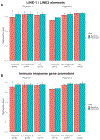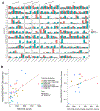Characterization of the immune response in patients with cancer of the oral cavity after neoadjuvant immunotherapy with the IRX-2 regimen
- PMID: 34717154
- PMCID: PMC8982160
- DOI: 10.1016/j.oraloncology.2021.105587
Characterization of the immune response in patients with cancer of the oral cavity after neoadjuvant immunotherapy with the IRX-2 regimen
Abstract
Objective: IRX-2 is a homologous cell-derived multi-cytokine biologic with multifaceted immune modulatory effects that has been shown to induce increased lymphocyte infiltration into primary tumors in oral cavity carcinoma. Our objective was to characterize tumor immune gene expression and epigenomic changes after neoadjuvant IRX-2 immunotherapy in patients with squamous cell carcinoma of the oral cavity.
Methods: A randomized phase II trial was conducted of the IRX regimen 3 weeks prior to surgery for previously untreated patients with Stage II-IV oral cavity carcinoma. The treatment regimen consisted of low dose (300 mg/m2) cyclophosphamide (day 1) followed by 10 days of regional perilymphatic IRX-2 cytokine injections and daily oral indomethacin, zinc and omeprazole (Regimen 1) compared to the identical regimen without the IRX-2 cytokines (Regimen 2). The NanoString immune panel (730 genes) and Infinium MethylationEPIC BeadChip were performed to assess the gene expression and DNA methylation signatures, respectively, in pre- and post-immunotherapy tumor samples.
Results: A total of 51 and 79 immune-related genes were found upregulated and downregulated, respectively, in the samples from Regimen 1 patients after treatment, while 51 and 56 were found upregulated and downregulated in the samples for Regimen 2. When comparing the changes between the two regimens, we identified 9 genes significantly different, including DMBT1, a potential tumor suppressor, functioning in tumor invasion of head and neck cancer. The exploration of DNA methylation showed slight overall hypermethylation after treatment in both regimens, especially for Regimen 1 immune responders, and methylation-based cell type deconvolution demonstrated high concordance with tumor infiltrating T lymphocyte cell counts.
Conclusion: While a consistent patient response after treatment was observed, most changes were similar between regimens, indicating a subtle, targeted, or patient-specific effect of IRX-2 cytokines. Change in DMBT1 expression was a unique finding that will require further study to better understand its significance.
Keywords: Cytokine; Immunotherapy; NanoString; Neoadjuvant; Oral cavity carcinoma; Tumor infiltrating lymphocytes.
Copyright © 2021 Elsevier Ltd. All rights reserved.
Figures





References
-
- Argiris A, Karamouzis MV, Raben D, Ferris RL. Head and neck cancer. Lancet (London, England) [Internet]. 2008;371:1695–709. Available from: http://www.sciencedirect.com/science/article/pii/S014067360860728X - PMC - PubMed
-
- Ferlay J, Colombet M, Soerjomataram I, Mathers C, Parkin DM, Piñeros M, et al. Estimating the global cancer incidence and mortality in 2018: GLOBOCAN sources and methods. Int. J. Cancer 2019. - PubMed
-
- Seiwert TY, Burtness B, Mehra R, Weiss J, Berger R, Eder JP, et al. Safety and clinical activity of pembrolizumab for treatment of recurrent or metastatic squamous cell carcinoma of the head and neck (KEYNOTE-012): an open-label, multicentre, phase 1b trial. Lancet Oncol. 2016; - PubMed
Publication types
MeSH terms
Substances
Grants and funding
LinkOut - more resources
Full Text Sources
Medical

